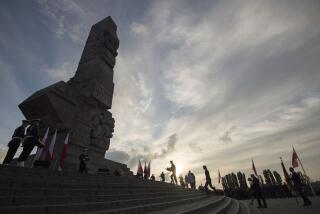Warsaw Remembers 200,000 Slain in 1944 Uprising
- Share via
WARSAW — It was 60 years ago today that the Warsaw uprising -- an ill-fated 63-day rebellion to liberate the Polish capital of Nazi occupation -- broke out.
Halina Szwykowska, 82, who left her small child with relatives to fight the Germans, remembers the mood: “It was an unforgettable moment of joy and enthusiasm. A bullet-sprayed white and red Polish flag was hoisted.... Loudspeakers were broadcasting the Polish national anthem and people opened windows and sang along. For a moment Warsaw was a free city.”
The rebellion failed, as had the Warsaw Ghetto uprising by the last 60,000 members of Warsaw’s Jewish population a year earlier.
This weekend, the 1944 uprising, in which an estimated 200,000 Polish civilians and fighters perished, is being remembered with a series of events. On Saturday, a Warsaw Uprising Museum opened and tonight, world leaders, including German Chancellor Gerhard Schroeder and U.S. Secretary of State Colin L. Powell, are scheduled to deliver speeches at a citywide observance.
In addition to commemorating the slain, the weekend events mark a milestone on the road to Polish-German reconciliation.
“I’m happy that Schroeder is coming,” Szwykowska said. “It is not his generation that is responsible, but it’s good for him to learn what his countrymen did to us.”
In 1944, after five years of Nazi occupation and with the Soviet army advancing, commanders of the Polish underground Home Army organized a rebellion.
Radio broadcasts from Moscow called on Poles to take up arms. Ill-equipped, the Polish commanders hoped to hold out for a week before the Soviets came to their aid and the British and Americans helped with airdrops of food and ammunition.
“Young people wanted to fight, to take revenge and free Warsaw,” remembers 80-year-old Henryk Gaska, a young corporal at the time of the uprising.
But things went wrong. After initial days of joy and enthusiasm in which the 40,000-strong army managed to liberate large sections of the city, it became clear that no help was coming. In the meantime, the Germans regrouped, sent in elite SS reinforcements and fought their way back, building by building.
German SS chief Heinrich Himmler issued an infamous order: “Kill every inhabitant, no prisoners are to be taken.” The city was to be “razed to the ground to set a terrifying example for all of Europe.”
Soviet leader Josef Stalin, who considered the Home Army anti-Soviet and planned to install a communist government in Poland, called the uprising a “mindless brawl mounted by adventurers.” The Soviets stood idly by on the east side of the Vistula River watching the destruction of the city.
The hungry and exhausted Polish fighters capitulated after two months. The survivors were deported to concentration camps. The Germans proceeded to systematically destroy the city. More than 80% of Warsaw was turned into rubble.
After the war ended and Poland fell under communist rule, the uprising was condemned and many of its heroes persecuted. For the Western powers, the uprising was an uncomfortable reminder of their inaction.
Norman Davies, an Oxford University historian and author, doubts that the West could have pressured Stalin into saving Warsaw. But it did not even try, Davies said in a Polish newspaper interview.
The “West did not even move a finger,” he said. “It did not even force the Kremlin to agree to the landing of airplanes with drops of help.”
Last year, on the 60th anniversary of the Jewish ghetto uprising, Polish President Aleksander Kwasniewski and Israeli officials placed wreaths at a large black granite monument in Warsaw. This weekend’s events are aimed at spotlighting the 1944 uprising.
“In the world there is general awareness what Nazis did to the Jews and to the Gypsies but there is almost no awareness of what they did to Poles,” said Szwykowska, the uprising veteran.
For more than 50 years, Gaska has taken a 200-mile train journey from the western city of Wroclaw to Warsaw every August to remember friends who fought alongside him and to light candles at the Powazki military cemetery where most of the insurgents are buried.
“Germans killed so many of our people, there was bloodshed. People were executed on the streets of Warsaw and we had to keep quiet,” Gaska says. “Now we felt our time has come.”
More to Read
Sign up for Essential California
The most important California stories and recommendations in your inbox every morning.
You may occasionally receive promotional content from the Los Angeles Times.










